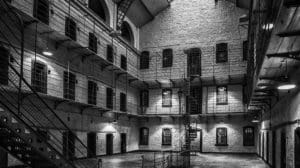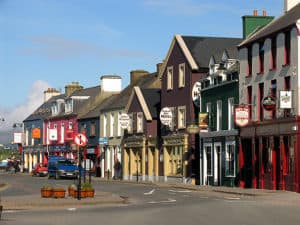The Legend of Finn McCool and Giant’s Causeway: Unveiling the Myth and Science

Updated On: April 22, 2024 by Maha Yassin
The legendary Finn McCool, or Fionn mac Cumhaill as known in Gaelic, is etched deeply in the rich tapestry of Irish folklore. His tale is inseparably linked to the striking Giant’s Causeway, located on the North Antrim coast in Northern Ireland. This natural wonder, made up of around 40,000 interlocking basalt columns, is steeped in myth and has long captivated the imaginations of those who visit. According to legend, the Giant’s Causeway was created by the mighty Finn McCool to bridge the gap between Ireland and Scotland, setting the scene for epic battles and adventures that have echoed throughout Irish culture for centuries.
Beneath the storybook allure of the Giant’s Causeway lies a fascinating geological history dating back 60 million years. While geological activity can explain the hexagonal columns scientifically, the legend of Finn McCool adds a layer of mystical charm that continues to draw visitors from all corners of the Earth. The Causeway offers a glimpse into the ancient past, both through the lens of science and the realm of myth. Today, it serves as a natural marvel and an emblem of Ireland’s cultural narrative, contributing significantly to the local economy through tourism while inspiring artists, writers, and storytellers.
Origins of the Legend
Finn MacCool’s legend is deeply rooted in Irish mythology, specifically within the narrative arc known as the Fenian Cycle. These stories celebrate heroism and adventure and serve as cultural touchstones for Ireland’s historical identity.
Irish Mythology
At the core of many Irish legends is the figure of Fionn mac Cumhaill, also known as Finn McCool. Irish mythology depicts him as a mighty warrior with intelligence to match his strength. Leader of the Fianna, a band of warriors, Finn McCool’s tales are passed down through the art of storytelling, underpinning much of Irish cultural heritage. According to tradition, the Giant’s Causeway results from an enormous feat by Finn, who created the causeway to bridge the gap between Ireland and Scotland.
Fenian Cycle
The Fenian Cycle, also known as the Fiannaíocht, is a collection of narrative poems and prose dating back to early Irish literature. Finn MacCool and his Fianna warriors undertake various adventures and challenges within this body of work. These stories often blend human and supernatural elements, resulting in a rich tapestry of myth and legend that reflects the beliefs and values of ancient Irish society.
Character Profiles
In this section, we introduce the key characters from the enchanting legend of the Giant’s Causeway. These mythic figures stand at the heart of one of Ireland and Scotland’s most famous tales, woven into the fabric of Celtic mythology.
Finn McCool
Finn McCool, also known as Fionn mac Cumhaill, is a prominent figure in Irish legend. A hunter-warrior known for his great size and strength, he is fabled to have created the Giant’s Causeway to traverse the North Channel. Finn’s intelligence and cunning are as notable as his bravery, often highlighted in tales where brute force alone could not ensure victory.
Oonagh
Oonagh is Finn McCool’s clever and resourceful wife. Her quick thinking played a pivotal role in saving Finn from confrontation with the Scottish giant. Oonagh’s ingenuity is celebrated, illustrating that one’s wits can be just as powerful as the strength of one’s muscles.
Benandonner
Benandonner, known as the Scottish giant, is often seen as Finn McCool’s formidable adversary. Tales depict him as massive and fierce, capable of defeating Finn in combat. The imagery of these two giants preparing for battle remains a stirring symbol of the cultural links between Ireland and Scotland, bound together by the legend of the Giant’s Causeway.
Geological Formation
Understanding the geological formation of the Giant’s Causeway involves delving into the details of its striking basalt columns and the volcanic activity which led to their creation.
Basalt Columns
The causeway is renowned for its distinctive hexagonal basalt columns. These structures formed approximately 50 to 60 million years ago due to a volcanic fissure eruption. As molten lava reached the surface, it cooled and contracted, creating cracks. Upon further cooling, these cracks deepened and propagated, forming the roughly 40,000 interlocking basalt columns, some of which reach up to 12 meters (roughly 39 feet) in height.
Volcanic Activity
The volcanic activity responsible for the Giant’s Causeway’s creation was part of a larger process that included the opening of the North Atlantic Ocean. During the Paleogene period, intense volcanic activity led to the outpouring of lava. Instead of exploding, the lava flowed from the volcanic fissure and spread across the area. When this molten lava came into contact with air and water, it cooled and crystallized into the hexagonally jointed columns we see today. This solidification process is similar to drying mud, which contracts and cracks, although the geological process occurs over a much longer timeframe and involves complex chemical reactions.
Cultural Significance
The legend of Finn McCool and the Giant’s Causeway holds a revered spot in our collective narrative, representing a crucial thread in the fabric of Irish folklore and identity. It symbolises the deep connections between Ireland and Scotland. It embodies key aspects of the Ulster Cycle, shedding light on the values and beliefs held by the Tuatha Dé Danann, the storied ancestors of Ireland.
Irish Culture
In Irish culture, storytelling is a cherished tradition that breathes life into the landscape and enriches our understanding of the world around us. The tales of Finn McCool (Fionn mac Cumhaill) play a significant role in this tradition, infusing the Giant’s Causeway with mythical significance. This extraordinary rock formation is said to be the remnants of a bridge built by Finn McCool from Ireland to Scotland.
- Finn McCool’s Story: A legendary warrior, Finn McCool epitomises the hero archetype within Irish folklore.
- Ireland and Scotland Connection: The lore connects these two lands through shared tales, revealing centuries of intertwined history.
The Giant’s Causeway itself is interwoven with these stories, serving as a physical manifestation of the mythic heritage that connects Ireland with its Celtic cousins across the sea. The site functions as a cultural landmark for its astounding geological features and as a testament to the power of Irish storytelling.
Ulster Cycle
The Ulster Cycle, known as a Rúraíocht in our language, is among the four major cycles of early Irish literary tradition, including Finn McCool’s story. Here, the narratives bridge the gap between the mythological and the historical:
- Cultural Richness: The Ulster Cycle contributes an extensive collection of tales passed down for centuries, forming a cornerstone of Irish mythological history.
- Tuatha Dé Danann: The legendary tribe figures prominently in our saga, illustrating the profound depth of Irish mythology and its pantheon of deities and heroes.
These stories imbue the landscape with a sense of wonder and illustrate the traditional Irish worldview. The tale of Finn McCool becomes a significant touchstone, providing a deeper connection to our past and a means to preserve our cultural identity for future generations.
The Causeway Today
The Giant’s Causeway symbolises natural wonder, blending ancient myth with geological marvel. Today, it’s a vibrant nexus of cultural heritage and tourism, captivating visitors from around the globe.
Tourism
We see the Giant’s Causeway as not merely a tourist attraction but a profound chapter in the narrative of our natural heritage. Every year, thousands of tourists are drawn to this stunning mosaic of basalt columns, lured by the enchantment of its legends and the spectacle of its natural beauty. The National Trust operates the visitor centre as a gateway to the causeway, offering interactive exhibitions that enrich the visitor experience. Beyond the centre, guided tours unfold across the rugged landscape, allowing tourists to tread the storied paths steeped in myth.
UNESCO World Heritage Site
Our stewardship at the Giant’s Causeway extends to its status as a UNESCO World Heritage Site, a designation it proudly received in 1986. This recognition underscores the site’s outstanding universal value, celebrating its scientific and cultural significance. As custodians, we’re committed to preserving the delicate balance between conservation and commercialism, ensuring that the allure of the Giant’s Causeway remains untarnished for future generations. The commitment to safeguarding this unique site reflects our devotion to heritage as we continue to maintain the legacy of the Giant’s Causeway against the pressures of modernity.
Legends Beyond Finn McCool
Beyond the tales of Finn McCool’s cunning and might, the landscape of Irish folklore is dotted with an array of mythical beings and stories. These enrich our cultural tapestry and serve as a bridge to the ancient world.
Mythical Creatures
Irish mythology speaks of the Fomhóraigh, or Fomorians, a supernatural race characterised as hostile and monstrous beings who came from the sea. They embody the chaos that exists outside the established order. The Giant’s Causeway, often linked to Finn McCool’s legend, is also whispered to have connections to these ancient entities, possibly serving as a haunt for these formidable figures.
Other Legends
Apart from Finn McCool, legends often spoke of the Red Man, a less-known giant, sometimes associated with the Scottish Isle of Staffa, which mirrors the geological features of the Giant’s Causeway. The interlocking basalt columns on the Isle of Man and Staffa serve as cultural threads that weave together a tapestry of Celtic mythology and tales of giants across Ireland and Scotland.
Historical Accounts
In exploring the legend of Finn McCool and Giant’s Causeway, it’s essential to delve into the historical accounts that have contributed to the story’s longevity. We’ll discover the earliest descriptions and observe how artists have captured the essence of this natural wonder over the years.
First Descriptions
The first known descriptions of the Giant’s Causeway date back to the 17th century. Susanna Drury, an artist of the time, is often credited with the earliest detailed illustrations of the Causeway. Her work gained recognition after being presented to the Royal Society in London, significantly raising the Causeway’s profile. Her artwork played a vital role in developing the site as an area of scientific interest and helped promote it as a natural world wonder.
Artistic Depictions
Artistic depictions of the Giant’s Causeway have varied throughout history, from Drury’s detailed engravings to its portrayal in popular media. Since her influential illustrations, the Causeway has been featured in numerous artworks across the centuries. More recently, it has been showcased in the popular television series Game of Thrones, where it served as a backdrop for the mythical lands of Westeros. Outside the realm of fiction, the nearby Bushmills whiskey distillery has also drawn inspiration from the Causeway for some of its branding, intertwining local legend with local produce.
The Causeway’s Natural Environment
Nestled along the rugged Antrim coast, the Giant’s Causeway is not only steeped in myth but also rich in natural beauty. Here, we explore the significant ecological aspects that make this area a marvel of conservation and biodiversity.
National Nature Reserve
The Giant’s Causeway is designated a National Nature Reserve, a testament to its ecological importance. This status ensures the protection of the area’s unique geological features and the diverse flora and fauna that call this place home.
As guardians of the Causeway’s natural environment, we recognise the reserve’s vital role in preserving the delicate balance between land and sea. The range of habitats, from rocky shores to grassy meadows, supports a variety of wildlife. On the Antrim coast, you may spot rare plant species adapted to the hexagonal basalt columns, and the intertidal areas host a rich marine life.
The variety of bird species that frequent the Causeway contributes to the auditory landscape of this natural wonder. From the skylark’s musical calls to the chough’s sharp cries, the area is a haven for birdwatchers. Mammals, such as the Irish hare, can also be sighted, gracefully navigating the terrain.
In highlighting the Giant’s Causeway’s National Nature Reserve, we emphasise the significance of preserving this unique corner of our planet. Our efforts ensure that the Antrim coast continues to be a source of natural splendour for future generations.
Myths and Science
In exploring the tale of Finn McCool and the Giant’s Causeway, we find ourselves at the crossroads of vibrant mythology and solid geology. Let us examine how these two realms intertwine and how scientific investigations have unravelled the secrets of this remarkable landmark.
Geology
The Giant’s Causeway, located on the scenic Causeway Coast, is renowned for its basalt columns, a natural marvel and a testament to Earth’s ancient volcanic activity. During the Paleogene period, these interlocking columns were formed approximately 50 to 60 million years ago. As the thick lava cooled, it contracted and cracked, creating the approximately 40,000 hexagonal columns we see today, some as tall as 12 meters and as wide as 28 centimetres in diameter. This geological wonder brings to life the story of the causeway’s creation.
Scientific Investigations
Scientific investigations into the Giant’s Causeway have consistently corroborated the geological story. Research reveals that the unique basalt formations resulted from volcanic activity, as lava flowed and solidified into the distinctive hexagonal shapes. Scientists use techniques such as radiometric dating to determine the age of these rocks, pinpointing the era of the causeway’s birth. Our understanding of the causeway is not static, as contemporary studies continue to shed light on its formation, sculpting a narrative grounded in geological processes.
Notable Locations Nearby

As we explore the mythological and geological wonder of the Giant’s Causeway, we must consider the other historically significant and visually striking sites. Among them are the Carrick-a-Rede Rope Bridge and Dunluce Castle, deeply rooted in Northern Ireland’s heritage and offering breathtaking views of the North Atlantic Ocean and North Channel.
Carrick-a-Rede Rope Bridge
Carrick-a-Rede Rope Bridge stands as an iconic coastal feature, connecting the mainland to the tiny island of Carrick-a-Rede. This rope bridge, suspended nearly 30 metres above the rocks, provides a thrilling experience alongside stunning views of the North Atlantic Ocean. Not only is it a testament to human engineering adapting to the forces of nature, but it also highlights the rugged beauty of the Antrim coast.
Dunluce Castle
Perched on the dramatic coastal cliffs of County Antrim is the historic Dunluce Castle. The ruins of this medieval stronghold date back to the 14th century and tell tales of the powerful McQuillan and MacDonnell clans. The castle’s location, on the edge of a basalt outcropping overlooking the North Channel, makes it a site of striking natural beauty and historic importance.
Impact on Local Economy
The Giant’s Causeway is not only a geological wonder but also a pivotal part of the local economy in Northern Ireland, significantly influenced by the legend of Finn McCool. The attraction boosts tourism, benefiting various aspects of the regional economy.
Ballyfin
In the heart of Ireland, Ballyfin has seen a positive impact, with visitors drawn to the country for its myths and legends. This small locality is a testament to the symbiotic relationship between heritage tourism and economic vitality. Guests often extend their stay to explore the rich narratives that places like Ballyfin have to offer.
Fort-of-Allen
Similarly, the Fort-of-Allen draws visitors eager to connect with the past. While perhaps lesser-known than the Causeway itself, the site captures the interest of those intrigued by Ireland’s storied history, which, in turn, supports small businesses and local heritage sites.
The symbiosis between legend and tourism has been particularly impactful in County Antrim, where the Giant’s Causeway is located. The town of Bushmills, for example, has benefited from generations of visitors eager to explore both the causeway and the local distillery, highlighting the importance of cultural attractions to regional economies.
The continuing appeal of attractions like the Giant’s Causeway, tied deeply to the legend of Finn McCool, illustrates mythology’s enduring power in shaping culture and driving sustainable economic growth across Northern Ireland and the broader Ireland.
Frequently Asked Questions
This section addresses some common queries surrounding the legendary figures Finn McCool and Benandonner and their connection to one of Ireland’s most storied landmarks, Giant’s Causeway.
Who were Finn McCool and Benandonner, and what is their significance in Irish folklore?
Finn McCool, known as Fionn mac Cumhaill in Irish, was a mythical hunter-warrior of the Fianna, a band of warriors from Irish mythology. Benandonner, or the Red Man, was a Scottish giant. Their significance in Irish folklore stems from tales of their incredible feats and battles, passed down for generations, forming an integral part of Ireland’s cultural heritage.
Can you summarise the story of Finn McCool and how it relates to the formation of Giant’s Causeway?
According to legend, Finn built the Giant’s Causeway to cross the North Channel and confront Benandonner. The story goes that after various altercations, Finn disguised himself as a baby to trick Benandonner into thinking that Finn must be colossal if his child was of such size. Fearing this prospect, Benandonner fled back to Scotland, destroying the causeway in his wake.
What are the differences between Scottish and Irish versions of Finn McCool legends?
There are slight variations in the legend between the Scottish and Irish versions. Scottish tales sometimes emphasise Benandonner’s strengths and cunning, whereas Irish versions of the legend highlight Finn McCool’s cleverness and valour. However, the core elements of the rivalry and the causeway’s creation remain consistent across stories.
How does the myth of Finn McCool explain the origins of Giant’s Causeway to children?
The myth simplifies the causeway’s origins into an engaging story about giants creating a pathway across the sea. To children, this tale presents a magical explanation for the unique hexagonal rock formations, making the natural wonder accessible to young imaginations.
Who are some of the other Irish giants in folklore besides Finn McCool and Benandonner?
In Irish folklore, several other giants exist, such as the Cyclopean builder of the Boyne Valley, known as the Dagda, and Oilliphéist, the great sea serpent. These giants represent the forces of nature and the ancient world, as Finn McCool and Benandonner do.
In what ways has the legend of Finn McCool influenced Irish culture and literature?
The legend of Finn McCool has substantially influenced Irish culture, maintaining a presence in literature, art, and oral traditions. It resonates with themes of courage, intelligence, and identity, serving as a source of national pride and a canvas for creative expression throughout Irish history.






